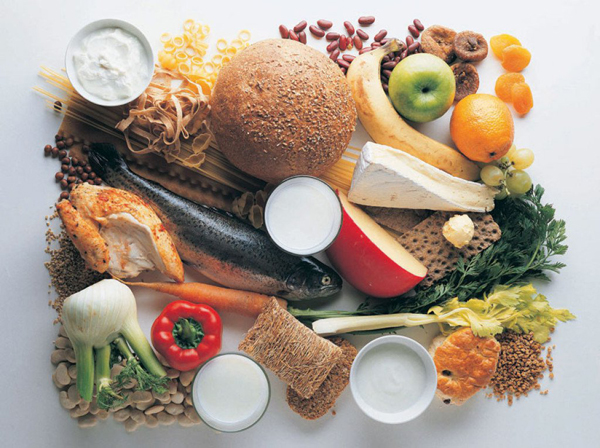
When trying to shed weight counting calories may not only come in handy in terms of portion control but also keeping an eye for nutrients you get (or don’t) with the foods you eat. There are many programs and apps that allow you to calculate the amount of calories you need to eat to maintain, lose, or gain weight. Weight loss becomes faily easy when you know your calorie target but let’s take a closer look at the calories and macros.
In order to be more specific you can use the following formula to calculate your BMR (Basal Metabollic Rate) also known as RMR (Resting Metabollic Rate), which is how many calories your body burns just to maintain itself (transfer oxygen, rebuild cells while at rest). This will be the number you can use as a limit beyond which you cannot reduce your daily calorie intake.
There a few formulas that allow you to calculate your BMR but we’ll take the one that’s considered to be the most accurate. The Mifflin-St Jeor equation looks like this:
Men
10 x weight (kg) + 6.25 x height (cm) – 5 x age (y) + 5
Women
10 x weight (kg) + 6.25 x height (cm) – 5 x age (y) – 161
Once you’re done calculating your BMR you can count your TDEE (Total Daily Energy Expenditure), which in contrast to BMR takes into account daily activity like exercise, walking, standing, cooking, etc. Then, you can subtract or add calories from your TDEE depending on your goals.
TDEE is comprised of such factors as Resting Energy Expenditure (REE), Activity Energy Expenditure (AEE), Thermic Effect of Feeding (TEF), Non-exercise Activity Thermogenesis (NEAT), and Excess Post-Exercise Oxygen Consumption (EPOC), which makes its calculation complicated. But since the formula to calculate BMR is also less accurate than the actual lab testing you can still find out a rough (not exact) estimate of your TDEE to help you on your weight loss journey. There are a few ways of calculating your TDEE from knowing your BMR. You can multiply your BMR by your activity level:
- Sedentary (little to no exercise)- BMR x 1.2
- Lightly active (light exercise/sports 1-3 days per week) – BMR x 1.375
- Moderately active (moderate exercise/sports 3-5 days per week) – BMR x 1.55
- Very active (hard exercise/sports 6-7 days per week) – BMR x 1.725
- Extra active (very hard exercise/sports and a physical job or 2x training) – BMR x 1.9
The TDEE number you will get from this formula can be reduce by 150 or 300 calories if your goal is weight loss. This may not be accurate but at least you will get the idea of how many calories you should be consuming approximately and how much you can cut down without slowing your metabolism and going hungry.

So now you know how many calories you should eat depending on your goal. Then what? You probably heard about macros (macronutrients) or maybe you wonder how much of your calories should come from carbs, protein, or fat. Well, those are macros. You can calculate them using a variety of methods. The recommended protein intake is 56g for adult men and 46g for women. In reality though your protein requirement depends on various factors like age, lifestyle, activity, health issues, and surely fitness goals.
In sports the recommended protein intake is 1g per pound of body weight, while the remaining should come from carbs and healthy fats. If you’re just starting you don’t want to cut down too much of carbs (but they better come from good sources like whole grains, fruit and veggies), so the best way to calculate your macros is using a textbook method, which recommends to consume 25% of fats and as much of protein along with 50% of carbs. For a 150 pound, 25 year-old, moderately active woman that would be 203g carbs, 101g protein and 45g of fat. Remember that protein and carbs have 4 calories per per gram while fat has 9.
Zone diet promotes the idea of balancing the consumption of protein and carbs. Built on the theory of hormonal balance Zone diet allows for 40% of diet to come from carbs, while 30% from protein and as much from fat.
If you ever heard of Atkins diet, it almost completely eliminates carbs considering them unessential to our diet with only 5% of diet coming from vegetables. But if you want to try a low carb diet (or you have to) don’t sweat. Reduce the carbs to 25% with 35% coming from fats and 40% from protein.
The IIFYM method (also known as flexible dieting) was invented by bodybuilders who were sick of boiled chicken breasts they had to scarf down pre-competition so now if it fits your macros (the meaning of that abbreviation) you can eat it guilt-free, yes, even a burger. How does it work? You still watch your calorie intake as well as exercise to burn calories. But when you plan your meals in that online food diary you can easily squeeze in some pasta or even ice-cream as long as it fits your macros. You should consume from 0.7g of protein per pound of body weight, 0.30g of fat per pound and the rest can come from your carbs. The numbers really depend on your goal.
This is how you calculate your calories and macros. The numbers are all approximate and rough. You can use various calculators online that use different other formulas and compare the numbers. Chances are many of them would revolve around one particular number. Logging your activity along with your food can give you a clearer picture of your actual calorie deficit.
Mona Liz
Latest posts by Mona Liz (see all)
- All About Sweat: 3 Must-Know Facts - June 15, 2016
- Mermaid Fitness Trend Is A Real Thing - June 13, 2016
- This Fitness Trend Got Millions People Interested - June 10, 2016













